

Alabama
1961-82 Crimson Tide
(Authentic Reproduction)
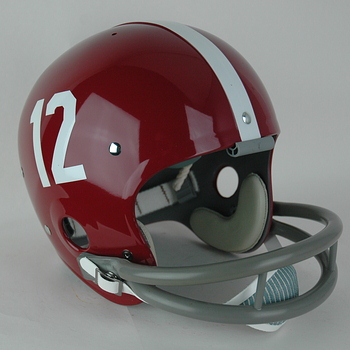 |
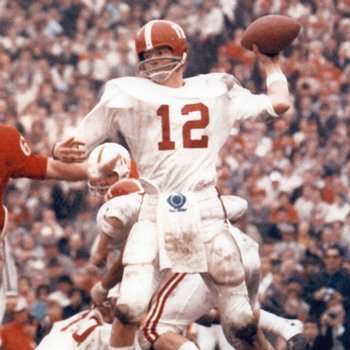 |
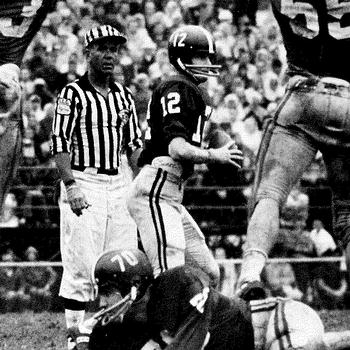 |
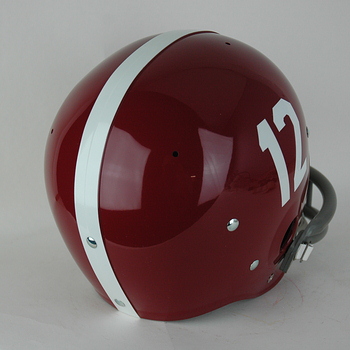 |
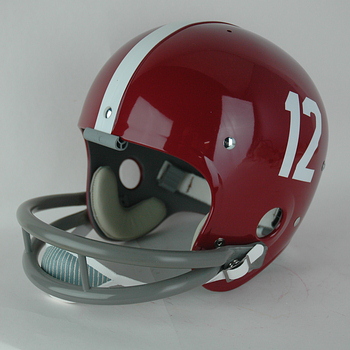 |
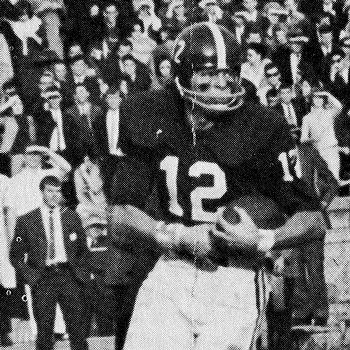 |
THE KEN STABLER YEARS, 1965 – 1967:
THE NATIONAL CHAMPIONSHIP SEASON OF 1965:
With Namath gone, Steve Sloan, who had filled in admirably when
Joe Willie was injured, had his turn leading the squad and he
was extremely successful despite an opening day 18-17 loss to
Georgia. He was named as an All American, taking the team to a
9-1-1 record, and finishing the year as National Champions.
Sloan played for the Falcons for two seasons but won greater
notice as a collegiate head coach at Vanderbilt, Texas Tech, Ole
Miss, and Duke. Halfback Steve Bowman, a two-time All SEC choice
led the conference in rushing and was with the Giants in ’66. A
concussion in 1967’s training camp, which later led to CTE ended
his pro career. Fullback Les Kelley showed potential as did
sophomore quarterback Ken Stabler who was used primarily as a
designated rusher. The line was led by lean tackle Cecil Dowdy
and All Conference end Tommy Tolleson who was with the Falcons
for a season. He returned to Bama as an assistant coach in ’68.
Ray Perkins and young Dennis Homan were primary receivers when
Sloan threw. A prominent weapon was All American kicker David
Ray who spent six seasons with the Rams after time with Montreal
in the CFL. Linebacker Paul Crane was an All American, and
played well for the Jets from ’66 to ‘72. Defensive end Creed
Gilmer and junior defensive back Bobby Johns added to the great
play of the defense as All SEC picks and linebacker Jackie
Sherrill completed his career and became a rather well known and
at times controversial head coach. He headed the programs at
Washington State, Pitt where he won fifty games in five years,
Texas A&M, and Mississippi State. The squad finished the season
with a strong 39-28 Orange Bowl victory over Nebraska. Observers
not only marveled at the depth that Bama displayed, but noted
that their 1965 freshman team could be the best in their
history. Helmet buffs noted the use of the white shell in the
October 30th victory over Mississippi State.
THE
“MISSING RING” SEASON OF 1966
A
magnificent 11-0 season in 1966 that finished with a blowout of
powerful Nebraska by a 34-7 score in the Sugar Bowl was
frustrating for Bryant and his Tide as the hype surrounding
Notre Dame and Michigan State’s so-called “Game Of The Century”
left Alabama ranked number three in the major polls at the end
of the year. Bryant frequently called this team his “best ever”
and very much deserving of the National Championship. In
succeeding years, it was noted often enough in the media that
the refusal of the Southeastern Conference and Alabama to
integrate their football programs also caused some to place
their votes for either of the Midwest schools. The usual
crushing Tide defense was augmented by what was for the south, a
rather explosive offense as Bama put up thirty-plus points in
five of their contests. Credit was rightfully given to
quarterback Kenny Stabler who had backed up All American Steve
Sloan in 1965, and his herd of excellent offensive players. The
All SEC team looked like an Alabama convention: end Ray Perkins,
tackle Cecil Dowdy, guard John Calvert, and DB’s Bobby Johns and
Dicky Thompson. Wayne Trimble who played a number of offensive
back and receiving positions as an extremely versatile performer
was also All Conference and played DB with the Forty Niners in
’67. Another three players were second team All SEC including
defensive tackle Richard Cole who was named to a number of All
American teams. Tough tackle Dowdy, Johns, and Perkins were also
All Americans with Perkins later successful as an end with the
Colts for five seasons. He eventually became head coach of the
New York Giants before returning to the Capstone as Bryant’s
successor and left Alabama to take the head coaching job for the
Tampa Bay Bucs. The defense finished number two in the nation
with rover Bobby Childs, linebacker Mike Hall and defensive end
Mike Ford somewhat lost among the other stars but leading the
“hit” parade on a weekly basis. Les Kelley was the Tide’s big
back and played both fullback and linebacker for the expansion
Saints over three seasons as their very first number one draft
pick. Smaller David Chatwood came into Bama as a two-way back
who played primarily on defense until his final two seasons and
was a dependable ball carrier as was sophomore Ed Morgan. An
unheralded member of the team, Christ Vagotis, went on to a
lengthy coaching career as a college assistant, most under
former Alabama assistant Howard Schnellenberger. Vagotis served
on Bryant’s staff in ’68 and was with Schnellenberger as he
rebuilt Miami and Louisville’s fortunes and later served under
him at Florida Atlantic University. Even to this day, the third
place national finish of this Alabama team has been debated
fiercely with the book “The Missing Ring” by Keith Dunnavant
devoted to the controversy. Once again, the Tide defeated
Mississippi State while wearing their white helmets.
1967’s 8-2-1 record was still of “Alabama standards” but the
opening game 37-37 tie with Florida State and their high octane
offense gave notice that there was trouble afoot in Tuscaloosa
as thirty-seven points was the entire 1966 regular season yield
for the Tide defense. The stalwarts were still there with DB
Bobby Johns named All American and linebackers Mike Hall and
Bobby Childs earning All Conference recognition with defensive
end Mike Ford. The offense was solid behind All American Stabler
who was suspended in April for off-the-field behavior but earned
his way back onto the team. He went on to pro stardom primarily
as a Raider and then was with Houston and New Orleans after
first gaining seasoning with the Continental League Spokane
Shockers. He was a 2016 inductee to the Pro Football Hall Of
Fame. Flanker Dennis Homan also gained All American honors and
was the Cowboys first-round draft choice, playing with them from
1968 through ’70 and finishing his pro career with the Chiefs in
1972. All SEC guard Bruce Stephens was the big gun up front with
rushing power provided by David Chatwood and Purdue transfer
Pete Jilleba, a weight lifting and wrestling star from Madison,
N.J. who deadlifted 400 pounds in eighth grade. Losing the
Cotton Bowl game to Texas A&M and their head coach Gene
Stallings who was a former player and assistant coach under
Bryant, despite the psychological boost of donning their white
helmets, was but one sign of concern. Having entered the ’67
season with twenty-one consecutive wins and then having notable
lapses against inferior opponents despite winning, and of course
finishing the season with the Cotton Bowl loss caused some to
see problems down the road.
SPOTLIGHT ON KEN STABLER:
A
multi-sport star at Alabama’s Foley High School where he led the
football team to a 29-1 record, Ken “Snake” Stabler snubbed
Major League Baseball offers from the New York Yankees and
Houston Astros to play football for Bear Bryant. He served as
“the running quarterback” during his sophomore season but
blossomed in 1966 as a junior, throwing for 956 yards and
rushing for 397 more. He was Mr. Clutch, leading the Tide to an
undefeated 11-0 record and picking up the MVP Award after
slugging Nebraska in the Sugar Bowl. His winning fifty-three
yard run through the mud which gave Bama their 7-3 Iron Bowl
victory was the season highlight. The ’67 8-1-1 regular season
ended with a loss to Texas A&M in the Cotton Bowl but The Snake
was permitted to air it out to the tune of 1214 yards and both
All SEC and All America selections. His quarterbacking record at
the Capstone of 28-3-2 allowed him to join Joe Namath with both
honored as Alabama Quarterbacks of the Century. Picked by the
Oakland Raiders in the second round of the ’68 draft, Stabler
first spent the ’68 and ’69 seasons with the Spokane Shockers of
the Continental League. His time spent with the Raiders between
1970 and 1979 however, was exceptional and included four Pro
Bowls, two First Team All Pro honors in 1974 and ’76, the NFL
Most Valuable Player Award in ’74, and the Super Bowl XI
Championship. He was traded and played with the Houston Oilers
in 1980 and ’81, and completed his career with the New Orleans
Saints from ’82 through the 1984 season. Stabler, in addition to
the honors won at Alabama, was a 2016 inductee to the Pro
Football Hall Of Fame.
While most programs would be extremely happy with a succession
of eight-win seasons, the 8-3 record at Bama in 1968 included
two close conference losses, 10-8 to Ole Miss and 10-9 to
Tennessee which raised concerns. The 35-10 Gator Bowl stumble
against Missouri had fingers pointing to the underachieving
offense that scored but 177 points. Passer Scott Hunter shared
the quarterback role with Joe Kelly before truly taking charge
and fullback Pete Jilleba matured, running as a part of a trio
that included Pete Moore and Ed Morgan. All SEC guard Alvin
Samples had been shifted from defense but the consistent punch
wasn’t there. The defense was still star-studded with All
Americans Mike Hall, who brought his linebacking skills to the
Jets camp the following season and middle guard Sam Gellerstedt,
a fan favorite because of his 5’8”, 195 pound stature that
served to disrupt opponents’ plans. The soft-spoken Gellerstedt
was noted by Bryant as being the best middle guard he had ever
coached but he dropped out of school in the spring of 1969 and
transferred to Tampa where he played well enough to be voted
into their Athletic Hall Of Fame. Defensive end Mike Ford was
All Conference and 200 pound linebacker Bobby Childs, still
considered one of the Tide’s best completed his terrific career.
If interested in any of these Alabama helmets please click on the photos below.